
|
Sale 114
The New York Sale
| Anceint Judea from Private American and European Collections |
| |
| |
| Lot |
Photo |
Description |
Bidding |
Lot 20 |
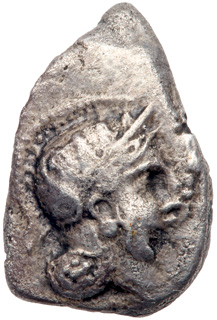 |
Philistia, Gaza. Silver Drachm (3.75 g), 4th century-333 BC. Imitating Athens. Helmeted head of Athena right, with profile eye. Reverse: AΘE, owl standing right, head facing; above, olive spray and crescent; in inner right field, 'Marnas' symbol; all within incuse square. Gitler & Tal V.21Da; HGC 10, 540. Extremely Rare. Lightly toned. A most unusual and very appealing example. Very Fine. Value $2,500 - UP
Ex Tareq H.N. Collection.
View details and enlarged photos
|
|
Lot 21 |
 |
Judaea, Yehud (Judah). Silver 1/2 Gerah (0.27 g), before 333 BCE. Left ear. Reverse: "YHD" (Paleo-Hebrew), falcon standing left, wings displayed. Cf. Hendin 428 (obol); MCP 01/R1; cf. TJC 18 (same). The famous "Ear of God" type. Very Rare. Unusually choice quality. Extremely Fine. Value $4,000 - UP
View details and enlarged photos
|
|
Lot 22 |
 |
Judaea, Hasmonean Kingdom. John Hyrcanus I. Æ Prutah (2.44 g), 134-104 BCE. Jerusalem. 'Yehohanan the High Priest and Head of the Council of the Jews' (Paleo-Hebrew; wedge-style characters) in five lines within wreath. Reverse: Double cornucopiae adorned with ribbons, pomegranate between horns; A below to right. Hendin 1137; Hendin GBC 4, 460 (this coin illus.); TJC grp. I. Extremely Fine. Value $200 - UP
Ex David Hendin Collection.
View details and enlarged photos
|
|
Lot 23 |
 |
Judaea, Hasmonean Kingdom. Alexander Jannaeus (Yehonatan). Æ 1/2 Prutah (1.80 g), 103-76 BCE. Jerusalem. 'Yehonatan the King' (Paleo-Hebrew), upright palm branch, within circular beaded border. Reverse: Lily, within circular beaded border. Hendin 1147; TJC grp. O. The finest specimen in private hands. Superb Extremely Fine. Value $2,500 - UP
The palm branch and lily types of this rare issue of Alexander Jannaeus take their inspiration from an earlier coinage of his father, John Hyrcanus I, probably as a means of visually indicating his legitimacy. Legitimacy was a perennial problem for Jannaeus, who was constantly at violent odds with the Pharisees who challenged his right to be High Priest. When they pelted him with fruit at the Feast of Tabernacles he responded by crucifying hundreds of his political opponents. This led to a slow-burning civil war between Jannaeus and his subjects that dragged on for six years.
View details and enlarged photos
|
|
Lot 24 |
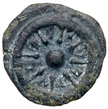 |
Judaea, Hasmonean Kingdom. Alexander Jannaeus (Yehonatan). Æ Prutah (6.20 g), 103-76 BCE. Jerusalem. 'Yehonatan the King' (Paleo-Hebrew) between the rays of star with eight rays, all within diadem. Reverse: BAΣIΛEΩΣ AΛEΞANΔPOY, inverted anchor. Hendin 1150a; TJC grp. K. Rarely seen like this. Heavy weight and with full detail. Extremely Fine. Value $500 - UP
Easily the most well known of Alexander Jannaeus' prutah coinages, this issue boldly advertises his status as king while paying attention to Jewish prohibitions against graven images of living things which had evolved since the time of the Yehud coinages in the fourth century BCE. While contemporary Seleukid and Ptolemaic kings regularly had their diademed portraits shown on their coins, Jannaeus was forced to content himself with depicting a star - apparently as a cipher for his image - surrounded by a diadem. It is unclear whether the star was meant to give a messianic flavor to Jannaeus' somewhat brutal style of kingship, but the anchor reverse casts him as a successor to dying Seleukid power in the Southern Levant.
View details and enlarged photos
|
|
Lot 25 |
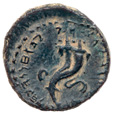 |
Judaea, Herodian Kingdom. John Hyrcanus I. Æ 2 pruthot (4.40 g), 134-104 BCE. Uncertain Samarian mint (?). 'Yehohanan the High Priest and Head of the Council of the Jews' (Paleo-Hebrew), double cornucopiae adorned with ribbons. Reverse: Helmet with decorative crest right. Hendin 1136, the plate coin and Hendin GBC 4, 462 (this coin illus.); TJC grp. H. Extremely rare, specially so in this high state of preservation. Extremely Fine. Value $20,000 - UP
According to Hendin, this rare coin is the only Hasmonean type that was not struck with beveled edges and for this reason it is suggested that it was not struck at the Jerusalem mint, Samaria is often mentioned as a possibility.
View details and enlarged photos
|
|
Lot 26 |
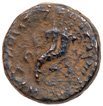 |
Judaea, Herodian Kingdom. John Hyrcanus I. Æ 2 pruthot (4.35 g), 134-104 BCE. Uncertain Samarian mint(?). 'Yehohanan the High Priest and Head of the Council of the Jews' (Paleo-Hebrew), double cornucopiae adorned with ribbons. Reverse: Helmet with decorative crest right. Hendin 1136; Hendin GBC 4, 462 (this coin illus.); TJC grp. H. Very Rare. Very Fine. Value $8,000 - UP
This type and denomination does not appear anywhere else in the Jewish series. This coin is considered one of the key rarities.
Ex David Hendin Collection.
View details and enlarged photos
|
|
Lot 27 |
 |
Judaea, Herodian Kingdom. Herod I. Æ Prutah (1.99 g), 40-4 BCE. Uncertain mint in Samaria, RY 3(38/7 BCE). Palm branch with objects (leaves?) to either side. Reverse: BAΣIΛEΩΣ HPΩΔOY, aphlaston; in left field, date (L Γ); in right field, monogram. Hendin 1172; cf. K.K.A. Lönnqvist, New Vistas on the Countermakred Coins of the Roman Prefects of Judaea, INJ 12 (1992-93), p. 70, 16 (year 17 instead of 18); TJC 47. Lovely reddish brown patina. Smoothing and tooling noted on the reverse. Choice Very Fine. Value $300 - UP
View details and enlarged photos
|
|
Lot 28 |
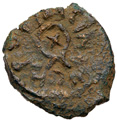 |
Judaea, Herodian Kingdom. Herod I. Æ 2 Prutot (2.69 g), 40 BCE-4 CE. Jerusalem. BACIΛEOC HPOΔOY, cross within closed diadem. Reverse: Tripod flanked by palm branches. Hendin 1178; Hendin GBC 4, 490 (this coin illus.); TJC 48. Choice Very Fine. Value $400 - UP
Ex David Hendin Collection.
View details and enlarged photos
|
|
Lot 29 |
 |
Judaea, Herodian Kingdom. Herod I. Æ Prutah (1.85 g), 40 BCE-4 CE. Jerusalem. BACIΛEOC HPΩΔOY, cross within open diadem. Reverse: Tripod-table in circle. Hendin 1179; Hendin GBC 4, 491 (this coin illus.); TJC 50. Very Fine. Value $200 - UP
Ex David Hendin Collection.
View details and enlarged photos
|
|
Lot 30 |
 |
Judaea, Herodian Kingdom. Herod I. Æ Prutah (1.43 g), 40 BCE-4 CE. Jerusalem. BACI HPW, anchor. Reverse: Double cornucopiae with caduceus between and dots above. Unpublished. Cf. Hendin 1188b; TJC 59. Unusually choice. Extremely Fine. Value $500 - UP
View details and enlarged photos
|
|
Lot 31 |
 |
Judaea, Herodian Kingdom. Herod I. Æ Prutah (1.33 g), 40 BCE-4 CE. Jerusalem. BACI HPW, anchor. Reverse: Double cornucopiae with caduceus between and dots above. Unpublished. Cf. Hendin 1188c; cf. TJC 59. Rare. Extremely Fine. Value $500 - UP
View details and enlarged photos
|
|
Lot 32 |
 |
Judaea, Herodian Kingdom. Herod II Archelaus. Æ Prutah (1.31 g), 4 BCE-6 CE. Jerusalem. HPW-Δ, anchor. Reverse: EΘ-N, double cornucopiae with caduceus between. Unpublished. Cf. Hendin 1192; cf. TJC 68. Pleasing contrasting earthen patina. Extremely Fine. Value $500 - UP
View details and enlarged photos
|
|
Lot 33 |
 |
Judaea, Herodian Kingdom. Herod II Archelaus. Æ Prutah (1.93 g), 4 BCE-6 CE. Brockage strike. Jerusalem. Incuse of reverse. Reverse: EΘNAPXOY, crested helmet; in left field, kerykeion. Hendin 1196b; Hendin GBC 4, 505b (this coin illus.); TJC 73. Reddish-brown patina. Very Fine. Value $200 - UP
Ex David Hendin Collection.
View details and enlarged photos
|
|
Lot 34 |
 |
Judaea, Herodian Kingdom. Herod II Archelaus. Æ 1/2 Prutah (1.80 g), 4 BCE-6 CE. Jerusalem. HPW around, prow of galley left. Reverse: EΘN within wreath. Hendin 1197; Hendin GBC 4, 506 (this coin illus.); TJC 72; RPC 4916. Pleasing dark green patina with earthen highlights. Choice Very Fine. Value $300 - UP
Ex David Hendin Collection.
View details and enlarged photos
|
|
Lot 35 |
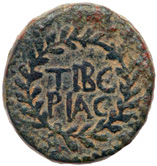 |
Judaea, Herodian Kingdom. Herod III Antipas. Æ Full denomination (18.87 g), 4 BCE-39 CE. Tiberias, RY 24 (20/1 CE). RY 24 (AD 20/1), TIBE/PIAC in two lines within wreath. Reverse: HPWΔOY TETPAPXO[Y], upright reed; across field, date (L KΔ). Hendin 1199; TJC 75. A fabulous example! Perfectly centered and the finest example we have handled. Contrasting olive-brown patina. Extremely Fine. Value $3,000 - UP
View details and enlarged photos
|
|
Lot 36 |
 |
Judaea, Herodian Kingdom. Herod III Antipas. Æ Half denomination (7.65 g), 4 BCE-39 CE. Tiberias, RY 34 (30/1 CE). TIBE/PIAC in two lines within wreath. Reverse: HPωΔOY TETPAPXOY, palm branch; across field, date (L ΛΔ). Hendin 1208; Hendin GBC 4, 517 (this coin illus.); TJC 84; RPC 4927. Rare. Dark green patina with earthen highlights. Very Fine. Value $800 - UP
Ex David Hendin Collection.
View details and enlarged photos
|
|
Lot 37 |
 |
Judaea, Procuratorial. Pontius Pilate. Æ Prutah (1.74 g), 26-36 CE. Jerusalem, RY 16 of Tiberius (AD 29/30). IOYΛIA KAICAPOC, three bound grain ears. Reverse: TIBEPIOY KAICAPOC, simpulum; at end of legend, date (L Iς). Hendin 1341; TJC 331; RPC 4967. Rough surfaces. Unusually well centered with complete legends. About Extremely Fine. Value $400 - UP
View details and enlarged photos
|
|
Lot 38 |
 |
Judaea, Procuratorial. Pontius Pilate. Æ Prutah (2.18 g), 26-36 CE. Jerusalem, RY 16 of Tiberius (AD 29/30). IOYΛIA KAICAPOC, three bound grain ears. Reverse: TIBEPIOY KAICAPOC, simpulum; at end of legend, date (L Iς). Hendin 1341; TJC 331; RPC 4967. Dark green and contrasting earthen patina. Extremely Fine. Value $300 - UP
View details and enlarged photos
|
|
Lot 39 |
|
Withdrawn
| |
Lot 40 |
 |
Judaea, Procuratorial. Pontius Pilate. Æ Prutah (1.40 g), 26-36 CE. Jerusalem, RY 17 of Tiberius (30/1 CE). TIBEPIOY KAICAPOC, lituus. Reverse: Date (L Iς sic) within wreath. Unpublished. Cf. Hendin 1342a; cf. TJC 333b; RPC 4968. A beautiful bold example. Choice Very Fine. Value $500 - UP
View details and enlarged photos
|
|
Lot 41 |
 |
Judaea, Procuratorial. Pontius Pilate. Æ Prutah (1.83 g), 26-36 CE. Jerusalem, RY 17 of Tiberius (30/1 CE). TIBEPIOY KAICAPOC, lituus. Reverse: Date (L IZ (Z retrograde)) within wreath. Unpublished. Cf. Hendin 1342a; TJC 333b; RPC 4968. Very Fine. Value $400 - UP
View details and enlarged photos
|
|
Lot 42 |
 |
Judaea, Procuratorial. Pontius Pilate. Æ Prutah (2.08 g), 26-36 CE. Jerusalem, RY 17 of Tiberius (30/1 CE). TIBEPIOY KAICAPOC, lituus. Reverse: Date (HZ (=L IZ)) within wreath. Unpublished. Cf. Hendin 1342b; TJC 333d; RPC 4968. Excellent contrasting earthen patina. Choice Very Fine. Value $400 - UP
View details and enlarged photos
|
|
Lot 43 |
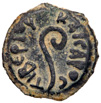 |
Judaea, Procuratorial. Pontius Pilate. Æ Prutah (1.89 g), 26-36 CE. Jerusalem, RY 17 of Tiberius (30/1 CE). TIBEPIOY KAICAPOC, lituus. Reverse: Date (HZ (=L IZ)) within wreath. Unpublished. Cf. Hendin 1342b; TJC 333d; RPC 4968. A wonderful clear example with greenish patina and earthen highlights. Extremely Fine. Value $400 - UP
View details and enlarged photos
|
|
Lot 44 |
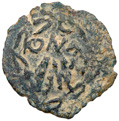 |
Judaea, Procuratorial. Porcius Festus. Æ Prutah (2.07 g), 59-62 CE. Jerusalem, RY 5 of Nero (58/9 CE). NEP/ωNO/C in three lines within wreath. Reverse: KAICAPOC (blundered), palm branch; in right field, date (L E). Unpublished. Cf. Hendin 1351 c-d; TJC 345; RPC 4972. Unusually choice. Nearly Extremely Fine. Value $600 - UP
View details and enlarged photos
|
|
Lot 45 |
 |
Judea, The Jewish War. Silver Shekel (13.04 g), 66-70 CE. Jerusalem, year 2 (67/8 CE). 'Shekel of Israel' (Paleo-Hebrew), ritual chalice with pearled rim, the base raised by projections on both ends; above, 'year 2'. Reverse: 'Jerusalem the holy' (Paleo-Hebrew), staff with three pomegranate buds, rounded base. Hendin 1358.; TJC 193; Deutsch 82 (O6, R78). Boldly struck and well centered. Lovely slightly iridescent mottled blue tone about the borders. A beautiful Jewish year 2 shekel. Superb Extremely Fine. Value $5,000 - UP
View details and enlarged photos
|
|
Lot 46 |
 |
Judaea, The Jewish War. Silver Shekel (14.18 g), 66-70 CE. Jerusalem, year 2 (67/8 CE). 'Shekel of Israel' (Paleo-Hebrew), ritual chalice with pearled rim, the base raised by projections on both ends; above, 'year 2'. Reverse: 'Jerusalem the holy' (Paleo-Hebrew), staff with three pomegranate buds, round base. Hendin 1358; TJC 193; Deutsch 122 (O8, R116). Lightly toned, boldly struck and well centered. Superb Extremely Fine. Value $5,000 - UP
View details and enlarged photos
|
|
Lot 47 |
 |
Judaea, The Jewish War. Silver Shekel (14.19 g), 66-70 CE. Jerusalem, year 2 (67/8 CE). 'Shekel of Israel' (Paleo-Hebrew), ritual chalice with pearled rim, the base raised by projections on both ends; above, 'year 2'. Reverse: 'Jerusalem the holy' (Paleo-Hebrew), staff with three pomegranate buds, round base. Hendin 1358; Deutsch 160 (O12, R161); TJC 193. Perfectly centered, well struck and lightly toned. Superb Extremely Fine. Value $5,000 - UP
Ex Maison Palombo 15 (22 October 2016), 22.
View details and enlarged photos
|
|
Lot 48 |
 |
Judaea, The Jewish War. Silver Shekel (14.17 g), 66-70 CE. Jerusalem, year 3 (68/9 CE). 'Shekel of Israel' (Paleo-Hebrew), ritual chalice with pearled rim, the base raised by projections on both ends; above, 'year 3'. Reverse: 'Jerusalem the holy' (Paleo-Hebrew), staff with three pomegranate buds, round base. Hendin 1361; Deutsch 20 (O3, R18); TJC 202. Nicely toned. Extremely Fine. Value $5,000 - UP
When the Jewish Revolt broke out in 66 CE, the revolutionaries quickly captured the holy city of Jerusalem, thus assuring them access to the great Temple for religious purposes and to its vast treasury as well. From the silver therein - presumably consisting of Tyrian coins paid in taxes over the years - they struck the most famous of all Jewish coins - the shekel.
The third year of the Jewish War saw some slight respite from the Roman advance as the death of Nero plunged the Roman Empire into a civil war into which Vespasian was drawn. However, violence in Jerusalem reached new heights as the Zealot leaders of the crushed northern revolt waged their own civil war against Ananus ben Ananus, the leader of the more moderate priestly authorities. This factional conflict resulted in an ignominious siege of Jerusalem by the Zealots and the slaughter of Ananus and his adherents. Jerusalem the holy, as it is described on the shekels, had been defiled by the blood of its own people before ever the Romans entered the city.
Ex Mel Wacks Collection, Purchased from Hans M. F. Schulman (6 May 1963), 255.
View details and enlarged photos
|
|
Lot 49 |
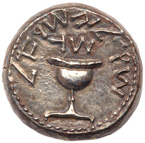 |
Judaea, The Jewish War. Silver Shekel (13.87 g), 66-70 CE. Jerusalem, year 3 (68/9 CE). 'Shekel of Israel' (Paleo-Hebrew), ritual chalice with pearled rim, the base raised by projections on both ends; above, 'year 3'. Reverse: 'Jerusalem the holy' (Paleo-Hebrew), staff with three pomegranate buds, round base. Hendin 1361; Deutsch 91 (O10, R84); TJC 202. Boldly struck with underlying luster present. Toned. Extremely Fine. Value $5,000 - UP
View details and enlarged photos
|
|
Lot 50 |
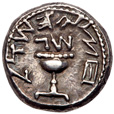 |
Judaea, The Jewish War. Silver 1/2 Shekel (6.77 g), 66-70 CE. Jerusalem, year 3 (68/9 CE). 'Half of a shekel' (Paleo-Hebrew), ritual chalice with pearled rim, the base raised by projections on both ends; above, 'year 3'. Reverse: 'Jerusalem the holy' (Paleo-Hebrew), staff with three pomegranate buds, round base. Hendin 1362; Deutsch 8 (O1, R8), Deutsch's recent study shows only 105 year 3 half-shekels known; TJC 203. Attractive old cabinet toning. Extremely Fine / Very Fine. Value $7,500 - UP
The Temple Tax was required of Jewish males over age 20, and the money was used for the upkeep and maintenance of the temple. In Exodus 30:13-16, God told Moses to collect this tax at the time of the census taken in the wilderness. In 2 Kings 12:5-17 and Nehemiah 10:32-33, it seems the Temple Tax was paid annually, not just during a census. This half-shekel tax wasn't a large sum of money, but roughly equivalent to two days' wages. Before the First Revolt, the Temple Tax could only be paid using Shekels or Half Shekels of Tyre. During the First Revolt, Judaean coins were used to pay the Temple Tax for the first time.
Ex Mel Wacks Collection.
View details and enlarged photos
|
|
Lot 51 |
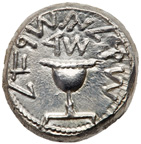 |
Judaea, The Jewish War. Silver Shekel (13.95 g), 66-70 CE. Jerusalem, year 4 (69/70 CE). 'Shekel of Israel' (Paleo-Hebrew), ritual chalice with pearled rim, the base raised by projections on both ends; above, 'year 4'. Reverse: 'Jerusalem the holy' (Paleo-Hebrew), staff with three pomegranate buds, round base. Hendin 1364; Deutsch 7 (O2, R7), Deutsch's recent study shows a total of only 53 known year 4 shekels. TJC 207. This being the finest specimen in private hands. Lustrous. Mint State. Value $40,000 - UP
The fourth year (AD 69) of the Jewish Revolt against Rome marked the beginning of the end for the rebels. Although they had enjoyed some initial success against forces sent against them by Cestius Gallus, the Roman legate of Syria in the first year of the revolt (AD 66), in the second year, command of the war was given to the general Vespasian, who immediately set about crushing the rebels in Galilee. By the end of the Galilee campaign of AD 67, Vespasian is said to have killed or enslaved some 100,000 rebels and had taken prisoner Joseph ben Matityahu, a man who had been the governor of Galilee for the rebel provisional government in Jerusalem, but became the historian of the Jewish Revolt under his Latin name, Flavius Josephus. In the third year (AD 68), Vespasian had established his headquarters at Caesarea Maritima and embarked upon new campaigns to repress Jewish rebels in Samaria, Idumaea and the hill country of Judaea, leaving only Jerusalem and its immediate environs as well as several fortresses, like Masada, in rebel hands. Vespasian halted his seemingly inexorable advance in the summer after news arrived that Nero had committed suicide and chaos reigned in Rome as military commanders raced to claim the imperial purple for themselves. At last, on July 1 of the fourth year of the Jewish Revolt (AD 69), Vespasian was proclaimed emperor by his troops and departed to take power in Rome, leaving his son Titus to carry on the war against the rebels.Unfortunately, the Jewish rebels did not make good use of the respite brought by the Year of the Four Emperors. Instead most of AD 68 and 69 was taken up by a civil war that erupted when John of Gischala the radical leader of the failed rebellion in Galilee withdrew to Jerusalem. There was already great tension in the city between Ananias ben Ananias, the priestly moderate leader of the rebel provisional government and the Zealots who had taken possession of the Temple. John initially supported Ananias in besieging the Zealots in the Temple, but then assisted the besieged in obtaining aid from the Idumeans. Ananias was killed in the resultant fighting and the Zealots splintered into two mutually hostile factions: one recognizing the leadership of John of Gischala and the other recognizing Eleazar ben Simon. The unstable rule of the Zealot factions became increasingly tyrannical and in early spring AD 69, the remnants of the shattered provisional government somewhat unwisely invited Simon bar Giora and his army of Sicarii ("dagger-men") into the city in an effort to regain some measure of control. A violent three-way conflict for dominance in Jerusalem ensued between the three factions that was only brought to a shaky truce by the arrival of Titus and his legions before the walls of Jerusalem in April AD 70. The fourth year of the Jewish Revolt had been frittered away on senseless and bloody fighting between faction leaders in Jerusalem when it could have been better used to fight the Romans before they reached the gates of the Holy City. By the time Titus was present and preparing for a siege it was far too late. Jerusalem and its people were thus condemned to an horrific fifth and final year of the Jewish Revolt by leaders who could not see the big picture, but only their own egos, and cared only for their own personal aggrandizement and power. The extremely rare shekels of the fourth year of the Jewish Revolt tend to be somewhat cruder in style and in the quality of engraving than the issues of the preceding three years, no doubt reflecting the political and military chaos in Jerusalem at the time of their production. The coins were probably struck within the Temple precinct and most likely from the silver collected in it, as there can have been few other sources of bullion for the beleaguered Jews in AD 69. Since John of Gischala and his Zealots controlled the Temple in year four of the Jewish Revolt it seems very likely that they were the driving force behind the shekels struck in this year.
View details and enlarged photos
|
|
Lot 52 |
 |
Judaea, Jewish War. AE 1/4 shekel (10.49 g), 66-70 CE. Year 4 (69/70 CE). 'Year four-quarter', two lulav bunches. Reverse: 'To the redemption of Zion', etrog. Hendin 1368; TJC 213. Unusually well centered and struck. Handsome olive-green and reddish patina. Choice Very Fine. Value $2,500 - UP
This is one of three bronze denominations issued in the fourth year of the revolt, presumably when the supply of silver was running low. All of these featured symbols associated with the harvest festival of Succoth.
Ex Mel Wacks Collection; Purchased from Hess-Leu 31 (7 December 1966), 537.
View details and enlarged photos
|
|
Lot 53 |
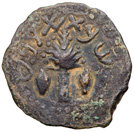 |
Judaea, The Jewish War. Æ Eighth (5.00 g), 66-70 CE. Jerusalem, year 4 (69/70 CE). 'Year four' (Paleo-Hebrew), lulav branch flanked by an etrog on either sider. Reverse: 'To the redemption of Zion' (Paleo-Hebrew), chalice with pearled rim. Hendin 1369; Hendin GBC 4, 670 (this coin illus.); TJC 214. Excellent detail. About Extremely Fine. Value $750 - UP
Ex David Hendin Collection.
View details and enlarged photos
|
|
Lot 54 |
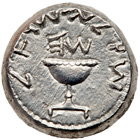 |
Judaea, The Jewish War. Silver Shekel (13.30 g), 66-70 CE. Year 5 (April-Augustus 70 CE). 'Shekel of Israel' around, 'year 5' above, ritual chalice with pearled rim. Reverse: 'Jerusalem the holy', sprig of three pomegranates. Hendin 1370; Deutsch 1 ((O1, R1), Deutsch's recent die study traces a mere 14 known year 5 shekels (not counting the "Baldwin" specimens); TJC 215. Extremely Rare and of great importance. Tied for the finest known. Lustrous and excellent metal. Mint State. Value $200,000 - UP
The fifth year of the Jewish Revolt was a complete nightmare for both the Jewish rebels and the citizens of Jerusalem. On April 14, AD 70, Titus, the son of Vespasian, invested the Holy City with his legions and allied forces, thereby beginning a siege that would last for four months, three weeks, and four days. By May, his forces had breached the Third and Second Walls of Jerusalem, essentially leaving only the Temple Mount in the control of the Jewish rebels. Although the Jewish rebels initially managed to repel Roman assaults, the highly pressurized situation soon deteriorated as the rebel leaders�most of whom had been rivals from the start of the revolt�began to fight among themselves. John of Gischala assassinated the Zealot leader Eleazar ben Simon and additional conflict between John and Simon bar Giora was only prevented by the discovery that Roman engineers were constructing ramparts against the walls with the intention of breaking through with battering rams.Faced with this new and very serious problem, the Jewish rebels took the unprecedented step of burning the dry food supplies in Jerusalem, apparently thinking that desperation would improve the fighting spirit of the defenders or hoping that it would call down divine intervention. It did neither. Instead, it sped the populace down the road to starvation. Under regular circumstances, the destruction of the food supplies would have spelled disaster for any besieged city, but in the case of Jerusalem the situation was made vastly worse by the fact that the siege had begun only a few days before the feast of Passover. Therefore, the regular population of the city was swelled by Jews who had come into the city from the Judean countryside and from abroad for the celebration of this important festival (more than a million people according to Josephus). Now all of the people were crammed within the wall surrounding the Temple Mount and facing starvation. The severity of the hunger experienced by those within the wall is reported by Josephus�an eyewitness to the siege�who describes people eating shoe leather and animals forbidden by the Jewish Law, as well as incidents of cannibalism. As the horror mounted in the rebel-held section of the city, the Romans continued the work of breaching the wall. The battering rams had little effect, and therefore several attempts were made to seize the Fortress Antonia, which overlooked the Temple precinct. The open assaults were repulsed by the defenders, but in early July Roman forces entered the fortress under cover of darkness and overpowered the sleeping rebel guards. Once Antonia was in Roman hands there could be little doubt that the Jewish Revolt was utterly doomed and Jerusalem could not be saved. From the superior position of the fortress, the Temple wall was set on fire. It was captured and destroyed in late August�a catastrophic event still commemorated by the Jewish fast day of Tisha B�Av. At last, on September 9, AD 70, the siege was over and Jerusalem was completely under Roman control. Titus is said to have lamented the destruction of the Temple as he had hoped to enlarge the original structure and reconsecrate it as a temple dedicated to the imperial cult and the gods of Rome. It is difficult to know what would have happened if he had actually made good on this supposed plan. When Hadrian actually did refound Jerusalem as Aelia Capitolina as a pagan cult center in AD 132 it sparked a new Jewish revolt under Simon bar Kokhba. Many thousands, if not the million reported by Josephus, were killed over the course of the siege through starvation, factional civil war, and the final Roman assault. Some 97,000 who survived were sold into slavery. Some of these were subsequently condemned to die as gladiators in bloody shows put on in the major cities of Roman Syria while others were taken to Rome to adorn the triumph of Vespasian and Titus before being put to work building the Colosseum�a monument to Roman victory entirely paid for by the spoils taken from Jerusalem. These included sacred items like the great seven-branched candelabra and the showbread table, both of which had previously been seen only by officiating Jewish priests but now appeared openly in the triumphal procession. Their display is commemorated by a famous panel on the Arch of Titus in Rome. John of Gischala and Simon bar Giora were captured alive and forced to march behind Titus� triumphal chariot. At the end of the triumph John was imprisoned for the remainder of his life while Simon was immediately executed. Both seem to have got off easy in comparison to the long suffering and miserable deaths meted out to their active followers and to those whose greatest crime was that they had the misfortune to be in Jerusalem on the day that it was besieged. The Jewish shekel of year 5 is simultaneously an extremely rare document of and a memorial to the horrific final year of the Jewish Revolt and the siege of Jerusalem. It carries the same types of a chalice (probably the Omer Cup used in Temple ritual) and pomegranate buds (a Jewish priestly symbol) found on shekels and half-shekels of previous years, but features an irregular engraving style that has also been noted for issues of year 1 and year 4. The coin was most likely struck in the Jerusalem Temple precinct using silver obtained from the Tyrian silver shekels and half shekels that had long been collected as annual tribute from adult male Jews throughout Judaea and the Diaspora. In year 5, with Jerusalem besieged, there can have been no other source of bullion. Interestingly, the Tyrian coins were apparently melted down and cast into new blanks for the Jewish Revolt issues since there is no evidence of overstriking. When silver coins were produced later to support the Bar Kokhba Revolt (AD 132-136) the new types were commonly overstruck on Roman Provincial issues. Despite the desperate straits that the Jewish rebels found themselves in in AD 70, they still seem to have taken greater care about the production standards of their coinage than their counterparts in the second century. The great rarity and deep historical interest of the year 5 shekel really make it the crown jewel for any Jewish coin collection.
View details and enlarged photos
|
|
Lot 55 |
 |
Judaea, The Jewish War. Æ 'Shekel' (6.84 g), 66-70 CE. Gamla, ca. February-August 67 CE. Crude uncertain legend around (either Paleo-Hebrew or Aramaic), omer cup. Reverse: Crude uncertain circular legend around (either Paleo-Hebrew or Aramaic), without design. Hendin 1372; Deutsch 2. TJC 217. Extremely Rare. Nearly identical in style and quality to Bromberg II, lot 390 and superior to the Deutsch plate example. Fine. Value $15,000 - UP
In AD 66, frustration with the excesses of Roman rule, conflicts with Greek neighbors, and the struggle between Jewish religious and political factions led to rioting in Caesarea and Jerusalem. The riots quickly developed into an open Jewish rebellion against the Roman procurator of Judaea, Gessius Florus, and his superior, Cestius Gallus, the legate of Syria. Gallus assembled an army to repress the revolt and was poised to besiege Jerusalem when his forces were slaughtered in a rebel ambush at Beth Horon. This signal success inspired the leaders of the rebellion to form an independent provisional government in Jerusalem and to assign regional commanders to defend against the inevitable Roman invasion that was to come once the shock of Beth Horon had worn off. Yosef ben Matityahu, more widely known as the future historian of the Jewish Revolt Ti. Flavius Josephus, was given command of the forces in Galilee and Golan, but his authority was challenged by John of Gischala, a leader of the radical Zealot faction.
Reprisals for the defeat of Gallus began in earnest in AD 67, the second year of the Jewish Revolt (AD 66-72). The Roman general Ti. Flavius Vespasianus was placed in command of operations to crush the rebels and started his bloody work in Galilee and Golan. Ignoring the will of the Judean provisional government, the elites of Galilean cities like Sepphoris and Tiberias surrendered without a fight. The town of Gamla (named for its location on a steep hill resembling the hump of a camel) probably would have done the same�it initially resisted the developing Jewish Revolt�if it had not been flooded with rebels seeking refuge from other parts of Galilee conquered by Vespasian. Josephus hastily ordered the erection of walls between the houses at the perimeter of the town in order to make it defensible against the Roman advance. At last on October 12, AD 67, Vespasian arrived before Gamla with a force of 60,000 men, according to Josephus. The defenders numbered only 9,000 and this is probably an exaggeration. Faced with the odds against them, the rebels would have been wise to surrender, but instead continued to resist with the unreasonable hope that aid would come from the Jews of the Babylonian Diaspora and the Parthian Empire.
The defenders of Gamla initially repulsed Roman attempts to construct a siege ramp, but eventually it was built and the walls were breached in three places. Entering the town, the Romans suffered greatly in the cramped hand-to-hand street fighting that followed. Many sought a superior position from which to attack the rebels and made their way to the roofs of the houses, but these collapsed under their weight. The loss of life incurred during the storming of Gamla caused the Romans to withdraw, but they returned a few days later and took the town. The surviving inhabitants and rebels were killed by the victorious Romans or died from injuries sustained while trying to escape through a nearby ravine. Gamla was destroyed and never rebuilt.
The present bronze coin (a token shekel?) is a memorial of the siege and the desperate resistance of Gamla�s defenders. Archaeological finds show that these coins were struck as a kind of emergency money at Gamla in imitation of the silver shekels struck by the provisional government in Jerusalem. Despite the crudeness born of necessity, it is still possible to make out the chalice (the Omer Cup of the Temple) obverse type regularly found on the silver shekels of the Jewish Revolt, however the expected pomegranates of the silver shekel is absent reverse. Due to the crudeness of the legends they have been read differently by different scholars. There is even some disagreement over whether they are written in paleo-Hebrew or Aramaic script. Readings have included "for the redemption of / holy Jerusalem," mimicking the legends of the silver shekels; "Gamla [year] 2 / holy Jerusalem"; and "y[ear]…to the Jewish People." This extremely rare coin (Hendin reports only 2-4 in private collections worldwide while the Menorah Coin Project is aware of only 9 specimens in total), is an absolute must for serious collectors of Jewish Revolt coins.
View details and enlarged photos
|
|
Lot 56 |
 |
Judaea, Roman Administration. Vespasian. Æ 20 (8.42 g), AD 69-79. Caesarea Maritima. Laureate head of Vespasian right. Reverse: Nike standing right, resting foot on helmet, inscribing shield hanging on palm tree. Hendin 1445; Hendin GBC 4, 742 (this coin illus.); TJC 380; RPC 2310. Very Rare. Dark brown patina with lighter highlights. Choice Very Fine. Value $2,000 - UP
Ex David Hendin Collection.
View details and enlarged photos
|
|
Lot 57 |
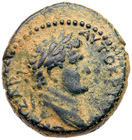 |
Judaea, Roman Judaea. Titus. Æ 21 (9.53 g), AD 79-81. Judaea Capta issue. Caesarea Maritima. Laureate head of Titus right. Reverse: Nike standing right, resting foot on helmet, inscribing shield attached to palm tree. Hendin 1446 and Hendin GBC 4, 743 (this coin illus.); TJC 381; RPC 2311. Well defined with brown and olive-green contrasting patina. Choice Very Fine. Value $800 - UP
Ex David Hendin Collection.
View details and enlarged photos
|
|
Lot 58 |
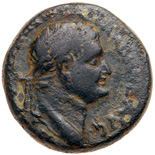 |
Judaea, Roman Judaea. Domitian. Æ 24 (13.25 g), AD 81-96. Judaea Capta issue. Caesarea Maritima, AD 81/2. Laureate head of Domitian right. Reverse: Titus standing facing, head right, holding spear and parazonium. Hendin 1451 plate coin; Hendin GBC 4, 753 (this coin illus.); TJC 387; RPC 2301. Rare. Smoothed olive-brown patina. About Very Fine. Value $1,500 - UP
Ex David Hendin Collection.
View details and enlarged photos
|
|
Lot 59 |
 |
Judaea, Roman Judaea. Domitian. Æ 25 (11.33 g), AD 81-96. Judaea Capta issue. Caesarea Maritima, AD 81/2. Laureate head of Domitian right. Reverse: Nike standing facing, head left, holding wreath and palm. Hendin 1452, this being the plate coin and Hendin GBC 4, 752 (this coin illus.); TJC 388; RPC 2302. Very Rare, the finest example we have seen. Olive-brown patina with earthen highlights. About Very Fine. Value $1,500 - UP
Ex David Hendin Collection.
View details and enlarged photos
|
|
Lot 60 |
 |
Judaea, Roman Administration. Domitian. Æ 14 (2.33 g), AD 81-96. Caesarea Maritima, under Agrippa II, 81/2 CE. IMP DOMITIANVS CAESAR DIVI F AVG, laureate head of Domitian right. Reverse: Rudder. Hendin 1453 (this coin illus.); I. Carradice, Coinage in Judaea in the Flavian Period, AD 70-96 INJ 6-7 (1982-3), pl. 3, 22; TJC 389; RPC 2303. Rare. Glossy brown patina with earthen highlights. Choice Very Fine. Value $600 - UP
Ex David Hendin Collection.
View details and enlarged photos
|
|
Lot 61 |
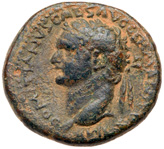 |
Judaea, Roman Judaea. Domitian. Æ 24 (11.54 g), AD 81-96. Judaea Capta issue. Caesarea Maritima, ca. AD 83 or later. Laureate head of Domitian left. Reverse: Athena standing facing, head left, crowning trophy before her and holding spear and shield. Hendin 1455, this being the plate coin and Hendin GBC 4, 749 (this coin illus.); TJC 392; RPC 2305. A very choice example of this issue. Olive-brown patina with earthen highlights. Very Fine. Value $600 - UP
Ex David Hendin Collection.
View details and enlarged photos
|
|
Lot 62 |
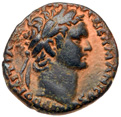 |
Judaea, Roman Judaea. Domitian. Æ 17 (4.67 g), AD 81-96. Judaea Capta issue. Caesarea Maritima, ca. AD 83 or later. Laureate head of Domitian right. Reverse: Nike advancing left, holding wreath and trophy. Hendin 1456; Hendin GBC 4, 750 (this coin illus.); TJC 393; RPC 2306. Pleasing brown and tan contrasting patina. This example far nicer than the current Hendin plate coin. Extremely Fine. Value $500 - UP
Ex David Hendin Collection.
View details and enlarged photos
|
|
Lot 63 |
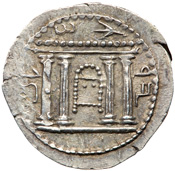 |
Judaea, Bar Kokhba Revolt. Silver Sela (14.52 g), 132-135 CE. Year 1 (132/3 CE). 'Jerusalem' (Paleo-Hebrew), tetrastyle façade of the Temple of Jerusalem; show bread table or Ark of the Covenant in chest form with semicircular lid and short legs, seen from a narrow side. Reverse: 'Year one of the redemption of Israel' (Paleo-Hebrew), lulav with etrog at left. Hendin 1373; Mildenberg 1 (O1/R3); TJC 218. Very Rare. A magnificent year one sela, quite beautiful. Toned. Extremely Fine. Value $50,000 - UP
Most of the silver Bar Kochba coins were overstruck upon tetradrachms of Antioch commonly circulating in Judaea at that time. They served as a declaration of independence from Rome, since only sovereign entities could mint coins in silver, and in their overstriking, the rebels could simultaneously insult the emperor and make nationalistic declarations. David Hendin maintains that the inscription "First Year" had an "aggressive posture… The principal motive of the coins was both political and psychological-to make bold statements of Jewish sovereignty, whether or not it actually existed, to both Jews and Romans."The Temple façade on the obverse has been variously described as a schematic depiction of the destroyed Temple in Jerusalem, or perhaps as an imaginary sketch of a rebuilt Temple to come. It has been posited that the item within the two central columns is the Ark of the Covenant, an ark holding Torah scrolls, the showbread table, or possibly a stylized generic ritual chalice.On the reverse of the sela are represented the Four Species, the most important articles Jews utilize in the ritual observance of Sukkot, known as "The Holiday" while the Temple stood in Jerusalem.The Four Species are here depicted as the central object, the lulav (a bundle comprised of three of the species) and, to its left, the etrog (the fourth species). The objects used in the ritual celebration of the festival of Sukkot is commanded in Leviticus 23:40-41: "You shall take for yourselves on the first day [of Sukkot] the fruit of the citron tree (etrog), the branches of the date palm (tamar), twigs of a plaited tree [myrtle] (aravot), and brook willows (hasadim)… You shall celebrate it [Sukkot] as a festival for God …[This is] an eternal decree for your generations."After the destruction of the Temple (70 C.E.), Rabbi Yohanan ben Zakkai (who had escaped from the besieged Jerusalem in a coffin) ordered that the ceremony of the Four Species should be carried out as a memorial to the Temple. (Mehahot 65a).
Ex Goldberg 90 (2 February 2016), 3010.
View details and enlarged photos
|
|
Lot 64 |
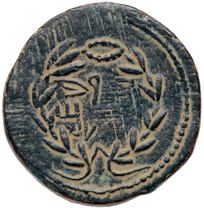 |
Judaea, Bar Kokhba Revolt. Æ Large Bronze (21.13 g), 132-135 CE. Year 1 (132/3 CE). 'Jerusalem' (Paleo-Hebrew) within wreath. Reverse: 'Year one of the redemption of Israel' (Paleo-Hebrew), amphora with two handles. Hendin 1375; Mildenberg 13 (O3/R9) only 1 example cited, this being finer; TJC 221. Very Rare. Uniform glossy olive-green patina. Adjustment marks as made. Rare Jerusalem obverse. Very Fine. Value $15,000 - UP
The rarest of all Bar Kokhba Revolt denominations is known by the Arabic nickname 'Abu Jara' meaning "father of the jar". While the obverse proudly spells out Jerusalem surrounded by a wreath being the focal point of the Revolt, the reverse features an amphora which scholars conclude was the vessel of oil that nourished the flames of the Temple Menorah.
View details and enlarged photos
|
|
Lot 65 |
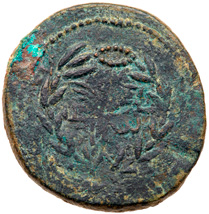 |
Judaea, Bar Kokhba Revolt. Æ Large Bronze 33 mm (23.13 g), 132-135 CE. Year 1 (132/3 CE). 'Jerusalem' (Paleo-Hebrew) within wreath. Reverse: 'Year one of the redemption of Israel' (Paleo-Hebrew), amphora with two handles. Hendin 1375; Mildenberg 13 (O3/R9); JC 221. Extremely Rare - Mildenberg notes just one specimen, this one not recorded. Dark green patina. Choice Very Fine. Value $10,000 - UP
Ex Shoshana Collection, pt. II (Heritage, 5 September 2012), 20136.
View details and enlarged photos
|
|
Lot 66 |
 |
Judaea, Bar Kokhba Revolt. Æ Large Bronze 31 mm. (17.65 g), 132-135 CE. Year 1 (132/3 CE). 'Jerusalem' (Paleo-Hebrew) within wreath. Reverse: 'Year one of the redemption of Israel' (Paleo-Hebrew), amphora with two handles. Hendin 1375 (plate coin) and Hendin GBC 4, 676 (this coin illus.); Mildenberg 12 (O3/R4) 13 cited; TJC 221. Very Rare. Contrasting reddish-green patina and earthen highlights. Very Fine. Value $9,500 - UP
Ex David Hendin Collection.
View details and enlarged photos
|
|
Lot 67 |
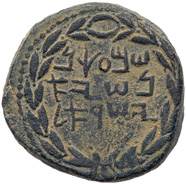 |
Judaea, Bar Kokhba Revolt. Æ Large Bronze (21.95 g), 132-135 CE. Year 1 (132/3 CE). 'Simon, Prince of Israel' (Paleo-Hebrew) within wreath. Reverse: 'Year one of the redemption of Israel' (Paleo-Hebrew), amphora with two handles. Hendin 1376; Mildenberg 10 (O2/R7), 27 cited; TJC 220b. An outstanding example with olive-earthen patina. About Extremely Fine. Value $9,500 - UP
The obverse now no longer mentions "Jerusalem" but now within the wreath names "Simon (bar Kokhba)" as the President of Israel, sometimes translated as "Prince".
View details and enlarged photos
|
|
Lot 68 |
 |
Judaea, Bar Kokhba Revolt. Æ Large Bronze 31 mm (17.67 g), 132-135 CE. Year 1 (132/3 CE). 'Simon, Prince of Israel' (Paleo-Hebrew) within wreath. Reverse: 'Year one of the redemption of Israel' (Paleo-Hebrew), amphora with two handles. Hendin 1376; Mildenberg 11 (O2/R8) Only 2 cited, this being #2 and plated; TJC 220b. Contrasting olive and green patina. Choice Very Fine. Value $7,500 - UP
Ex Shoshana Collection, pt. I (Heritage, p March 2012), 20234; Ex Leu 86, 5-5/6 2003, Teddy Kollek Collection, #546.
View details and enlarged photos
|
|
Lot 69 |
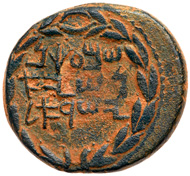 |
Judaea, Bar Kokhba Revolt. Æ Large Bronze 30 mm (17.80 g), 132-135 CE. Year 1 (132/3 CE). 'Simon, Prince of Israel' (Paleo-Hebrew) within wreath. Reverse: 'Year one of the redemption of Israel' (Paleo-Hebrew), amphora with two handles. Hendin 1376; Mildenberg 8 (O2/R3) only 8 cited; TJC 220b. Full lettering, thus very rare and most desirable. Contrasting earthen patina. Very Fine. Value $7,500 - UP
Ex Shoshana Collection, pt. I (Heritage, March 8-9, 2012), 20233; Ex LHS 95 (25 October 2005), #735.
View details and enlarged photos
|
|
|
|